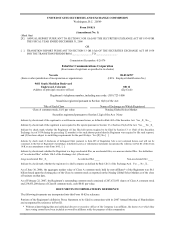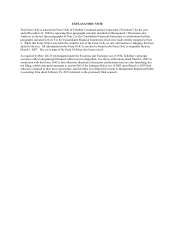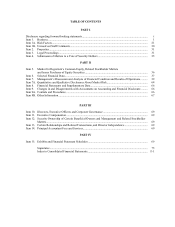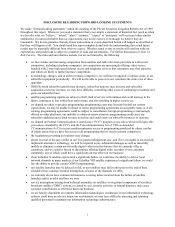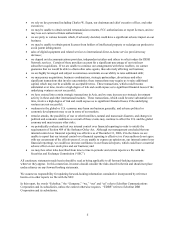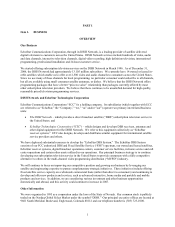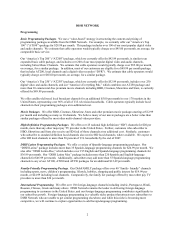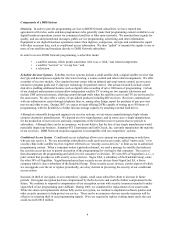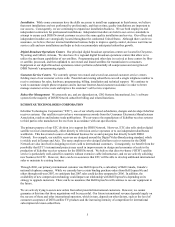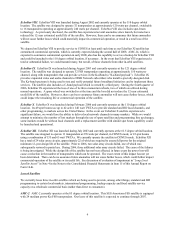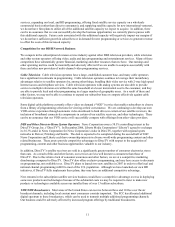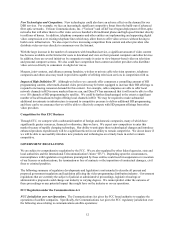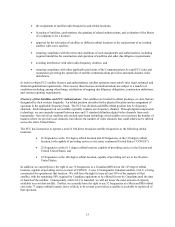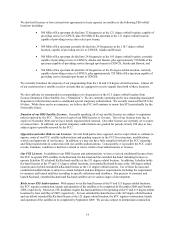Dish Network 2006 Annual Report Download - page 14
Download and view the complete annual report
Please find page 14 of the 2006 Dish Network annual report below. You can navigate through the pages in the report by either clicking on the pages listed below, or by using the keyword search tool below to find specific information within the annual report.4
Components of a DBS System
Overview. In order to provide programming services to DISH Network subscribers, we have entered into
agreements with video, audio and data programmers who generally make their programming content available to our
digital broadcast operations centers via commercial satellites or fiber optic networks. We monitor those signals for
quality, and can add promotional messages, public service programming, advertising, and other information.
Equipment at our digital broadcast operations centers then digitizes, compresses, encrypts and combines the signal
with other necessary data, such as conditional access information. We then “uplink” or transmit the signals to one or
more of our satellites and broadcast directly to DISH Network subscribers.
In order to receive DISH Network programming, a subscriber needs:
• a satellite antenna, which people sometimes refer to as a “dish,” and related components;
• a satellite “receiver” or “set-top box,” and
• a television.
EchoStar Receiver Systems. EchoStar receiver systems include a small satellite dish, a digital satellite receiver that
decrypts and decompresses signals for television viewing, a remote control and other related components. We offer
a number of receiver models. Our standard system comes with an infrared universal remote control, an on-screen
interactive program guide and V-chip type technology for parental control. Our advanced models include a hard
disk drive enabling additional features such as digital video recording of up to 300 hours of programming. Certain
of our standard and premium systems allow independent satellite TV viewing on two separate televisions and
include UHF universal remotes, allowing control through walls when the satellite receiver and TV are not located in
the same room. We also offer a variety of specialized products including HD receivers. Receivers communicate
with our authorization center through telephone lines to, among other things, report the purchase of pay-per-view
movies and other events. During 2007, we expect to begin offering DVRs capable of storing up to 500 hours of
programming, with the flexibility to further increase storage capacity by attaching external hard drives.
Although we internally design and engineer our receiver systems, we out-source manufacturing to high-volume
contract electronics manufacturers. We depend on a few manufacturers, and in some cases a single manufacturer,
for the production of our receivers and many components of the EchoStar receiver systems that we provide to
subscribers. Although there can be no assurance, we do not believe that the loss of any single manufacturer would
materially impact our business. Sanmina-SCI Corporation and Jabil Circuit, Inc. currently manufacture the majority
of our receivers. DISH Network reception equipment is incompatible with our competitors’ systems.
Conditional Access System. Conditional access technology allows us to encrypt our programming so only those
who pay can receive it. We use microchips embedded in credit card-sized access cards, called “smart cards,” or in
security chips in the satellite receiver, together referred to as “security access devices,” to limit access to authorized
programming content. When a consumer orders a particular channel, we send a message by satellite that instructs
the security access devices to permit decryption of the programming for viewing by that consumer. The receiver
then decompresses the programming and sends it to the consumer’s television. We own 50% of NagraStar L.L.C., a
joint venture that provides us with security access devices. Nagra USA, a subsidiary of the Kudelski Group, owns
the other 50% of NagraStar. NagraStar purchases these security access devices from NagraCard SA, a Swiss
company which is also a subsidiary of the Kudelski Group. These security access devices, certain aspects of which
we can upgrade over the air or replace periodically, are a key element in preserving the security of our conditional
access system.
Increases in theft of our signal, or our competitors’ signals, could cause subscriber churn to increase in future
periods. Our signal encryption has been compromised by theft of service and could be further compromised in the
future. We continue to respond to compromises of our encryption system with security measures intended to make
signal theft of our programming more difficult. During 2005, we completed the replacement of our smart cards.
While the smart card replacement did not fully secure our system, we continue to implement software patches and
other security measures to help protect our service. There can be no assurance that our security measures will be
effective in reducing theft of our programming signals. If we are required to replace existing smart cards, the cost
could exceed $100.0 million.



